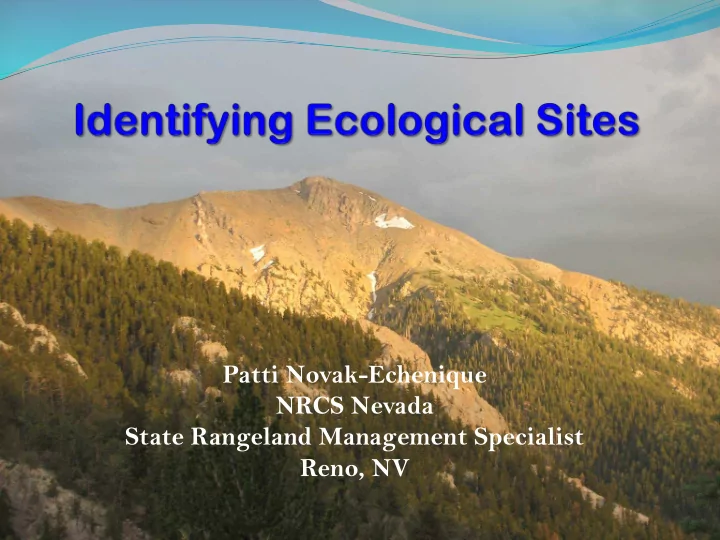

Patti Novak-Echenique NRCS Nevada State Rangeland Management Specialist Reno, NV
Ec Ecolo logic ical Sit Sites A framework for stratifying and describing rangelands for assessments, land suitability, and land management planning. Land (soil)-based classification system
Ecolo logic ical S Sit ite – Definiti nition ( on (2013) 3) An ecological site, as defined for rangeland, is a distinctive kind of land based on recurring soil, landform, geological, and climatic characteristics that differs from other kinds of land in its ability to produce a distinctive kinds and amounts of vegetation and in its ability to respond similarly to management actions and natural disturbances.
Ecolog logica ical S Site D Develop elopment ent Background information: literature, existing data, local expert knowledge, relict sites, photos Evaluate existing data – development of the ecological site concept Defining the ecological site ‘modal’ concept: soil properties, elevation, slope, aspects, vegetation dynamics – disturbance regimes, climatic variability Based on reference conditions representing natural states – developed within the natural range of variability
Ecolog logica ical S Site D Descr crip iptions tions Physiographic Features Climatic Features Influencing Water Features Representative Soil Features Plant Communities - description & dynamics, models, growth curves, function, structure, cover Management Interpretations Other Information
Inter teragency y Effort MOU (2013)– BLM/NRCS/USFS Interagency Workgroup – develops/recommends policy, procedures and data management for the development and use of ESD’s. January 2013: Interagency Ecological Site Handbook for Rangelands
Land ndfor orms and Soils ils Hill shoulder Backslope Floodplain Drainageway
Claypan 10-12 Aspen Thicket/Aspen Woodland) Claypan 10-12
Stony Mahogany Savanna Mountain Ridge Aspen Woodland Loamy 12-16
Ecolog logica ical S Site D Descr crip iptions tions Management interpretations: Fire – different states in the same ecological site may react differently to fire Forest/woodland – manage pest outbreaks and documents vegetation change Hydrology – provide information on site characteristics such as erosion potential Grazing – how grazing affects plant composition and ecological processes Invasive species – STM’s highlight vulnerable ecological sites and states Restoration – some states are easier to change than others Wildlife – ESD’s prioritize areas for habitat projects
Agenc ncy A Applica icati tions ons ESD’s can be used at different planning levels: Strategic (National), Operational (State/Regional), Tactical (Ranch/Allotment) National: Development of consistent data collection methodologies and protocols Consistent training tool and information source Relationship with other classification systems Incorporate into landscape functional units – GIS/Soil/ESD mapping tools
Nationa onal L l Level Strategic – (National Level) ESD’s help set realistic management objectives. Ex – ‘Utilize ESD’s to conduct land health assessments to determine if standards of rangeland health are being met. Develop specific objectives to conserve, enhance, or restore priority sage grouse habitat based on ESD’s and assessments’. A Report on National Greater Sage-Grouse Conservation Measures – by the Sage-Grouse National Technical Team12/2011
State a te and R Regional L ional Level el Operational: Refine the planning unit to areas that respond similarly Provide baseline information for land health assessments and monitoring Incorporate GIS/Soil/ESD’s into effective mapping tool Watershed interpretations – erosion potential, hydrologic condition
Allotm tmen ent L t Level el Implementation of conservation practices: What is possible? What’s the likelihood of success or failure? What are the costs? Determine goals and objectives Determine carrying capacity
Regio iona nal o or Allo llotment t Lev evel: Refine Planning Units using Disturbance Response Groups for monitoring and land health assessments
Regio iona nal Lev evel: Wildlife Interpretation: Prioritize sage grouse habitat areas
Ecological Sites near Active Leks Elko County, NV: 214 Active leks – 5km buffer Claypan 10-12: 65 (30%) Claypan 12-16: 47 (22%) Loamy 8-10: 44 (21%) Shallow Clay Loam 10-14: 19 (9%) Shallow Calcareous Loam 8-10: 19 (9%) Loamy 10-12: 13 (6%) Shallow Calcareous Loam 10-14: 4 (2%)
Water ersh shed ed Lev evel: Invasive Species Management – STM’s highlight vulnerable ecological sites and states
Ranc nch L Level el Applica licatio tions ns Grazing Management – STM’s describe how grazing affects plant composition and ecological processes; what species to manage for; carrying capacity Invasive Species – what species are more vulnerable to disturbances (spread/establishment) Fire Management – describes the role of fire in vegetation change, reduce fire risk, etc. Restoration or Range Improvements – what actions are most likely to have a positive impact/prioritize areas
Ranch/ h/Allot otme ment nt L Level Conser servation P Pract actice A ce Applica cations Brush Management (314) Prescribed Burning (338) Prescribed Grazing (528) Range Planting (550) Restoration & Management of Rare and Declining Habitats (643) Riparian Forest Buffers (391) Tree/Shrub Establishment (612) Upland Wildlife Habitat Management (645)
Brus ush M h Managem ement ent – Cr Crea eate the the desir ired ed p plant c nt communi nity ty c consis iste tent nt wit ith t the ecolo logi gical s sit ite
Pha Phase 3 3: Pi Piny nyon n and nd J Juni uniper Removal – Mecha hanic nical C Cutting ng
Wildfir ire R e Restor toratio tion n – STM’s h help lp priori oritiz tize a e areas as w where e restor toratio tion i n is most l likely ely t to succeed ceed
Finally… ESD’s provide: A common framework for communication of resource information among disciplines, agencies and organizations. I nformation describing the interactions amount soils, vegetation and land management. A foundation to assess current condition, management opportunities, and monitor changes. A framework for transferring experience and knowledge.
http:/ / soils.usda.gov
http:/ / esis.sc.egov.usda.gov/
Recommend
More recommend